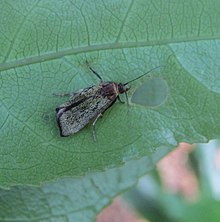| Hierodoris callispora | |
|---|---|

| |
| Holotype | |
| Scientific classification | |
| Domain: | Eukaryota |
| Kingdom: | Animalia |
| Phylum: | Arthropoda |
| Class: | Insecta |
| Order: | Lepidoptera |
| Family: | Oecophoridae |
| Genus: | Hierodoris |
| Species: | H. callispora |
| Binomial name | |
| Hierodoris callispora (Meyrick, 1912) | |
| Synonyms | |
| |
Hierodoris callispora is a moth of the family Oecophoridae. It is endemic to New Zealand and can be found throughout the country from south of the Bay of Plenty. This species inhabits native beech forest. Adults of the species have been found where Muehlenbeckia is common. Adults have also been collected from the flowers of Kunzea ericoides. However the larval host is unconfirmed although it has been hypothesised that larvae of this species feed on Kunzea ericoides flowers. Adults of this species can be distinguished by its orange ruff that contrasts with its dark head and thorax. There is a colour form that exists that has orange scales and an orange coloured fringe on the hindwing. Adults have been collected in December and January and are day flying but are also attracted to light at night. A female specimen has been found with a larva in her oviduct suggesting that this species may give birth to larval young.
Taxonomy

This species was first described by Edward Meyrick in 1912 and named Heliostibes callispora using a specimen collected in January by George Hudson in Wellington. In 1988 J. S. Dugdale placed this species within the genus Hierodoris. The holotype specimen is held at the Natural History Museum, London.
Description

Meyrick described this species as follows:
♂. 17 mm. Head deep metallic-green, with purple reflections, collar ferruginous-orange. Palpi ferruginous-orange, terminal joint rather more than half second, blackish anteriorly. Antennae dark fuscous, ciliations 1⁄3. Thorax shining deep greenish-purple-bronze. Abdomen dark fuscous. Forewings elongate, posteriorly dilated, costa slightly arched, faintly sinuate in middle, apex obtuse, termen straight, little oblique, rounded beneath; dark indigo-fuscous, closely strewn with pale greenish-yellowish hair-scales : cilia fuscous, basal third dark fuscous mixed with deep ferruginous. Hindwings blackish; cilia fuscous, with blackish basal shade.
This species can be distinguished by its orange ruff that contrasts with its dark head and thorax. There is a colour form that exists that has orange scales and an orange coloured fringe on the hindwing.
Distribution
This species is endemic to New Zealand and can be found throughout the country from south of the Bay of Plenty.
Behaviour and biology
Adults of this species have been collected in December and January and are day flying but are also attracted to light at night. A female specimen has been found with a larva in her oviduct suggesting that this species may give birth to larval young.
Habitat
This species inhabits native beech forest. Hudson states that adults of the species have been found where Muehlenbeckia is common. The larval host is unconfirmed although adults of this species have been collected from the flowers of Kunzea ericoides. It has been hypothesised that larvae of this species feed on those flowers.
References
- ^ Robert Hoare (24 December 2005). "Hierodoris (Insecta: Lepidoptera: Gelechioidea: Oecophoridae), and overview of Oecophoridae" (PDF). Fauna of New Zealand. 54. Manaaki Whenua – Landcare Research: 31–32. doi:10.7931/J2/FNZ.54. ISSN 0111-5383. OCLC 946510444. Wikidata Q44994400. Archived from the original (PDF) on 20 February 2021.
- ^ Edward Meyrick (1912). "Glyphipterygidae". Exotic Microlepidoptera. 1 (2): 41. Wikidata Q109544348.
- Dugdale , J. S. (23 September 1988). "Lepidoptera - annotated catalogue, and keys to family-group taxa". Fauna of New Zealand. 14. Department of Scientific and Industrial Research: 89. doi:10.7931/J2/FNZ.14. ISSN 0111-5383. Wikidata Q45083134.
- "Hierodoris callispora (Meyrick, 1912)". www.nzor.org.nz. Retrieved 2021-11-12.
- Hudson, G. V. (1928), The butterflies and moths of New Zealand, Illustrator: George Hudson, Wellington: Ferguson and Osborn Limited, p. 306, LCCN 88133764, OCLC 25449322, Wikidata Q58593286
| Taxon identifiers | |
|---|---|
| Hierodoris callispora | |
| Heliostibes callispora | |